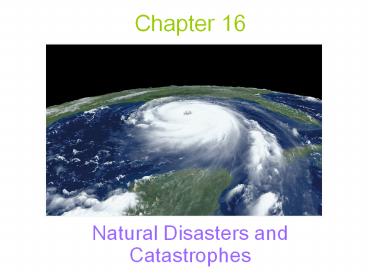Natural Disasters and Catastrophes - PowerPoint PPT Presentation
Title:
Natural Disasters and Catastrophes
Description:
Chapter 16 Natural Disasters and Catastrophes Hazards, Disasters, and Catastrophes The Most Devastating Natural Hazards -Earth Quake -Volcanic Eruption -Lands ... – PowerPoint PPT presentation
Number of Views:1549
Avg rating:3.0/5.0
Title: Natural Disasters and Catastrophes
1
Chapter 16
- Natural Disasters and Catastrophes
2
Hazards, Disasters, and Catastrophes
- The Most Devastating Natural Hazards
-Tsunami -Wildfire -Tornado -Flood -Drought
-Earth Quake -Volcanic Eruption -Landslides -Hurri
cane -Heatwave
3
(No Transcript)
4
Hazards, Disasters, and Catastrophes
- Natural Hazards
- Any natural process that is a potential threat to
human life and property - Disasters
- A hazardous event that occurs over a limited time
span in a defined geographic area where the loss
of human life and property is significant. - Catastrophes
- A massive disaster requiring significant time and
money for recovery.
5
Disasters and Catastrophes Taking a Historic
Point of View
- Natural Hazards are Repetitive Events
- Study History to reduce hazards
6
Fundamental Concepts
- Natural processes have service functions.
- Hazards are predictable
- Linkages exist between hazards
- Linkage exist between the physical and biological
environment - Hazards are producing more catastrophes than they
were before. - Risk from hazards can be estimated
- Adverse effects of hazards can be minimized
7
Natural Processes Have Natural Service Functions
- Physical processes create a varied landscape.
- Periodic disturbance such as earthquake, volcanic
eruption, and flooding create - Fertile soil
- Available water
- Diverse land and life
- Aesthetic beauty
8
Hazards Are Predictable
- Monitor areas where hazards have occurred in the
past. - Statistics can evaluate frequency of a particular
event. - Predict based on geography of where hazards are
most likely to occur. Ex. Earthquakes most like
near coastlines. - Forecast events and issue warnings. Ex. Tsunami
warning system in the Pacific Ocean.
9
Tsunami Warning System
10
Linkages Exist Between Hazards and the Environment
- Often one hazard can create another.
- Ex. Volcanic eruption can cause a landslide.
- Natural hazards are linked to earth materials.
- Ex. Weak soils can lead to landslides.
- Hazards can cause the disruption of ecosystems.
11
- Volcanic eruptions can cause mudslides
12
Hazards are Producing More Catastrophes
- Key Factor Human Population Growth
- Humans pushed into more hazardous areas
- 15 cities of over 10 million most vulnerable
- Land use transformation
- How we use land effects hazardous events
- Ex. Flooding of Yangtze River
13
YIKES!
14
Risk From Hazards can be Estimated
- Risk product of the probability of an event
times the consequences - Acceptable Risk Risks that individuals or
society are willing to take
15
Adverse Effects of Hazards can be Minimized
- Active vs. Reactive Response
- Need to be more active
- Land use planning
- Hazard-resistant construction
- Protection of ecosystems
- Evacuation plans
16
Impact and Recovery from Disasters
- Direct vs. Indirect Effects
- Direct effects effect relatively few
- Indirect effects can effect all of society and
can take years for recovery
17
Perceiving, Avoiding, Adjusting to Hazards
- Regulations about what can be built in hazardous
zones. - Best adjustment is to avoid hazards.
- Common adjustments
- Land-use planning
- Control natural processes
- Insurance
- Evacuation
- Disaster preparedness
- Do nothing
18
What Does the Future Hold?
- Major Disasters are increasing due to population
pressure and poor land-use planning. - Anticipating hazards
- will minimize
- suffering and
- economic losses
19
Your Assignment
- Work in the assigned groups of 3.
- Create a two to three minute presentation
explaining your topic. - Feel free to be creative.
- Dont necessarily need to make a PPT.
- Your topic must address each question.































